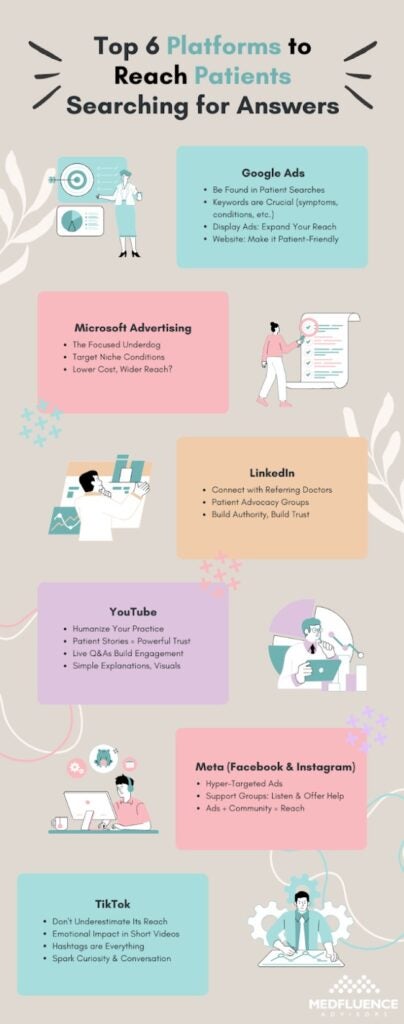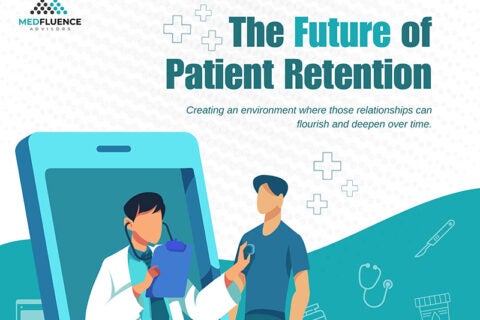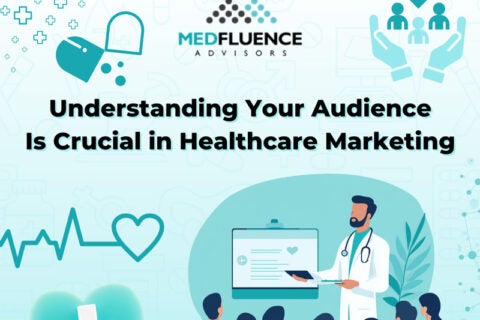Top 6 Advertising Platforms To Connect Medical Practices With Patients
Living with an undiagnosed or latent disease is an isolating experience. Patients may feel dismissed or misunderstood by a medical system that struggles to provide answers. This lack of clarity leaves those suffering in limbo, their lives put on hold while they search for treatments, cures, or even simply a name for their condition. Nowadays, innovative physicians offer life-changing procedures to these patients. But how can these patients easily find the right specialists? This is where strategic advertising enters the picture. This guide aims to provide the strategies medical practices need to attract and engage their ideal patients online.

Your Mission, Your Voice

Your goal is to break the silence and to let patients know they are not alone. You have treatments that offer long-term relief. The path to recovery may be arduous, but with your guidance, it’s possible. The question is: How do you reach them in the first place?
The answer lies in a multi-faceted advertising approach, utilizing the best platforms to spread your message:
1. Google Ads
When someone is actively searching for solutions to their medical problems, Google is likely their first stop. With Google Ads (combining Search and Display Ads), you position your practice directly in their search for solutions. Here’s how to make the most of this powerful platform:
- Search Ads: Understand that over 70,000 health-related searches are conducted on Google every minute. Target keywords and phrases directly related to your treatments, patient struggles, and undiagnosed symptoms. This ensures your ads appear when those relevant searches are happening.
- Display Ads: Expand your presence by carefully partnering with reputable medical websites and health information portals. This keeps your practice visible even when someone isn’t actively searching, subtly guiding them toward your expertise.
Google Ads can be a powerful tool, but don’t neglect your website! Ensure it’s clear, informative, and built to guide patients toward taking the next step, whether that’s booking an appointment or seeking further information.
2. Microsoft Advertising
Consider Microsoft Advertising the “thoughtful underdog.” While it doesn’t have Google’s massive reach, Bing and its partner networks offer a distinct advantage – a focused audience often engaged in in-depth research.
- Targeting Unexpected Niches: Due to Microsoft’s integration with products like Outlook and the Edge browser, your ads can reach users who may be actively seeking information on lesser-known conditions, second opinions, or alternative treatments. This, combined with Microsoft Advertising’s typically lower cost-per-click (CPC) compared to Google, could translate to a wider reach for your budget, ultimately connecting you with more patients.
- A Professional Edge: Microsoft Advertising’s network includes LinkedIn, often used for professional networking and information gathering within the medical community. Use this to your advantage!
Microsoft Advertising offers the potential to connect with a highly engaged audience seeking informed solutions. This makes it a surprisingly strong option for targeting specific medical conditions or treatments.
3. LinkedIn
While LinkedIn isn’t a direct-to-patient platform, it’s incredibly powerful for your mission. Here’s why:
- Forge Doctor Partnerships: Connect with physicians searching for innovative treatments for their patients. Emphasize how your procedures improve the quality of life for those with poorly understood conditions. Physicians are constantly seeking information and collaboration on LinkedIn, and with over 65 million decision-makers using the platform, it is ideal for reaching this influential audience.
- Patient Advocacy: Target and support groups for undiagnosed diseases; offer educational resources and potential paths to treatment. LinkedIn groups offer a focused space for discussion, allowing you to directly interact with engaged communities seeking solutions.
LinkedIn is about fostering valuable relationships. Engage with referring physicians, build authority within your field, and connect with those seeking answers in patient groups. It might not directly lead to new patients right away, but it’s a long-term investment in both your practice’s reputation and patient outcomes.
4. YouTube
Medical conditions can be overwhelming and isolating. YouTube offers a unique way to break down complex concepts, humanize your practice, and create genuine connections with potential patients. Consider these strategies:
- Patient Testimonials: Nothing speaks more powerfully than the experiences of those who have found relief. With signed consent, share videos of patients discussing their journeys, diagnoses, and the transformative impact of your treatments. This approach taps into a powerful statistic: 91% of consumers watch videos to help them understand a product or service, establishing trust and relatability.
- Live Q&As: Host regular sessions with your knowledgeable doctors, answering common questions with both empathy and clear medical information. Live video content generates significantly more engagement and watch time compared to pre-recorded content, strengthening the connection with your audience.
YouTube prioritizes viewer engagement. Use compelling visuals, simple explanations, and authentic storytelling to connect with patients on a deeper level.
5. Meta Platforms (Facebook and Instagram)
Meta’s platforms boast vast audiences and highly specific targeting options, allowing you to pinpoint potential patients. Here’s how to maximize their potential:
- Hyper-targeted Ads: Design ads focused on specific undiagnosed or underdiagnosed conditions, relevant patient demographics, and locations where patients may be concentrated. Meta’s detailed targeting options, including interests in health and wellness, allow you to zero in on the most relevant audience for your message.
- Patient Support Groups: Join existing groups related to your areas of expertise (with a focus on providing support, not direct promotion). Offer educational resources, actively listen to patient concerns, and organically build awareness of your solutions over time. Social media support groups provide real-time insights into patient experiences, enhancing your understanding and positioning you as a trusted resource.
Meta platforms are about connection and community. Use targeted ads to reach the right people, and join support groups to establish trust and build your reputation while offering sincere support.
6. TikTok
While TikTok’s audience skews younger, don’t underestimate the platform’s power to reach those searching for answers on behalf of loved ones. Here’s how to maximize its potential:
- Short, Impactful Videos: Create concise, attention-grabbing videos highlighting symptoms of lesser-known conditions, patient struggles, and the emotional power of diagnosis and treatment. TikTok’s algorithm prioritizes short, engaging videos that generate repeat views, so focus on content that packs an instant punch.
- Hashtags: Strategically utilize relevant hashtags to increase your visibility in searches (#undiagnosed, #raredisease, #chronicillness, etc.). Effective hashtag use on TikTok can make your content significantly more discoverable by a wider audience with relevant interests.
TikTok is about emotional resonance and shareability. Craft impactful, relatable content that sparks conversation and encourages viewers to learn more.

Ethical, Empathetic Advertising

Throughout your advertising, prioritize honesty, data, and a human-centered approach. Avoid false promises or presenting your treatment as a miracle cure. Instead, frame it as a vital step toward relief. Highlight the challenges patients face by emphasizing that an estimated 30 million Americans suffer from rare diseases, many of which remain undiagnosed. Remember, patients are people, not just marketing targets. Infuse your ads with genuine compassion, prioritizing understanding and connection over hard sells.
Imagine the relief on a patient’s face after finally getting a diagnosis, or the hope a family feels when they discover a treatment option. Choosing the right platforms is just the first step. A successful campaign goes beyond clicks and conversions. It uses targeted messaging and heartfelt content that truly resonates with the struggles of patients and their loved ones. By doing this, you won’t just be growing your business, you’ll be playing a vital role in transforming lives and offering hope to countless individuals searching for answers.


